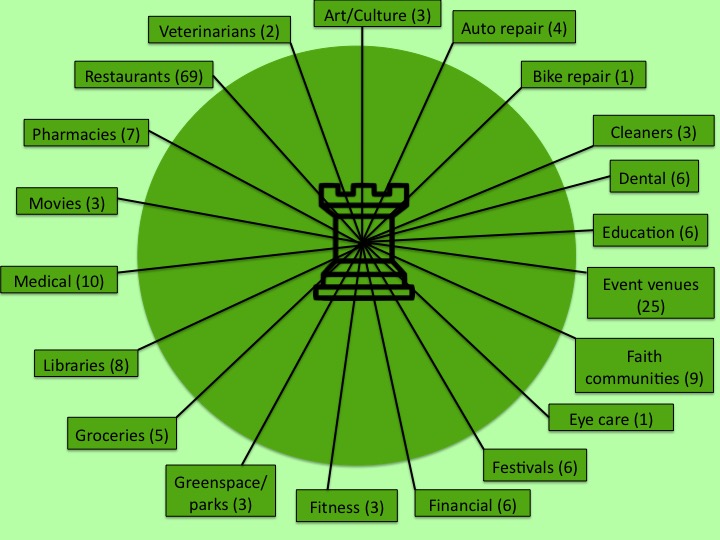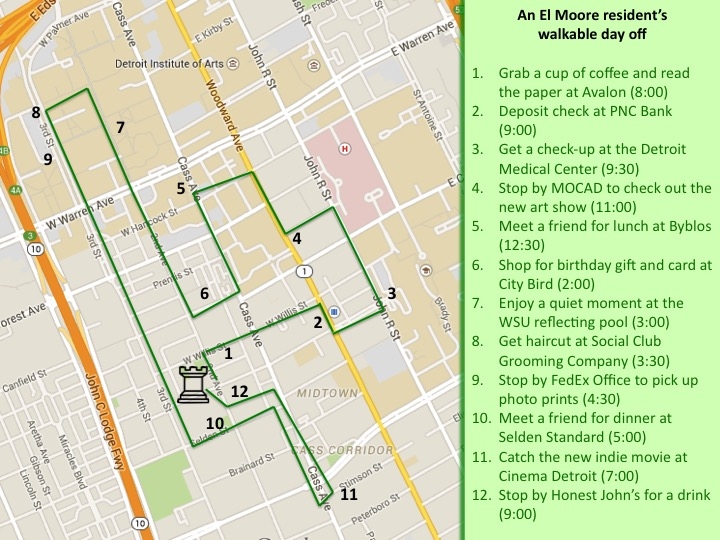This is the first in a four-part series co-authored by Kimberly Williamson and Matthew Piper exploring walkability and the El Moore.
We frequently refer to the El Moore project as an ongoing exploration of the nature of sustainable urban living. There’s a lot that factors into a more sustainable way of living in cities; one crucial element is a robust “transit ecosystem,” where the choice to walk, bike, or use public transportation is as viable as the choice to travel by car.
Here in the Motor City, where we have spent generations prioritizing auto travel at the expense of other modes of transit, we’re starting to better understand how important these alternatives are for individual and community well-being, long-term economic viability, and the general health of our local and global ecosystems.
Over the next few months, we’re going to hone in on one of these alternatives, walking, and explore it in the context of life at the El Moore and in Detroit more broadly.

Let’s start with the basics. We know that people around the country are increasingly calling for more walkable communities, but what do we even mean when we say walkability?
Walkability, simply defined, consists of three components:
1. Physical access: can you physically get from one place to the next by foot? For example, are there safe sidewalks? Adequate pedestrian crossings?
2. Places: are there a diverse mixture of places where typical needs can be met, e.g. stores at which to shop, parks, restaurants, and cultural institutions to visit?
3. Proximity: are the places we wish to go reasonably close, say within a mile of our home?
With this understanding in mind, we started thinking about walkability and the El Moore a few months ago, when we worked on a project to identify how many different establishments were within one mile of the El Moore, and therefore reasonably accessible by foot. (We chose the distance of one mile because research suggests that people are 40% more likely to walk to a destination when the destination is a mile or less away.)
We know that Midtown is generally understood as one of the more walkable parts of Detroit, but still, what we found surprised us. Did you know, for instance, that there are three dry cleaners within a mile of the El Moore? Six places to do your banking? Three places to see a movie? Sixty-nine places to get a bite to eat (and we counted before Selden Standard, Hopcat, and Falfil opened!)? We sure didn’t.
Here’s an overview of the different kinds of establishments located within one mile of the El Moore:
This research made us realize just how truly walkable the experience of living at the El Moore could be for future residents. So what, we wondered, might a resident’s walkable day off look like? With all those different establishments located within one mile of the building, it turns out you can pack an awful lot into a day in the neighborhood on foot.
Now, before we get to our hypothetical “day in the life of an El Moore resident” graphic, let us offer a disclaimer: what we present here is probably not going to be an average day by most people’s standards. It was just a little hard not to get carried away when we started imagining all the places someone could walk to on their day off. So, if you were a person who was into maximizing your time or simply a person who was a bit of an overachiever (or a maybe just a little neurotic?), maybe this is what your day off could look like. Anyway, every place our hypothetical over-achiever visits on her (busy) day off is, again, within one mile of the El Moore:
We were heartened by this insight into just how walkable the neighborhood around the El Moore really is, but this is just one part of a much larger story. What are the benefits of walkability to communities and individuals? How do local experts think the city of Detroit, in general, is doing with respect to walkability? And how can Detroiters across the city work to promote walkability in their neighborhoods? We’ll explore these questions and more in future posts.


